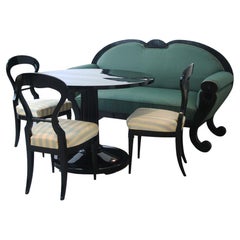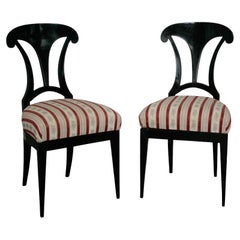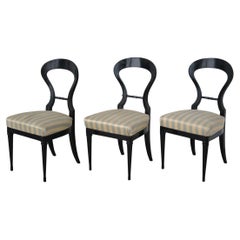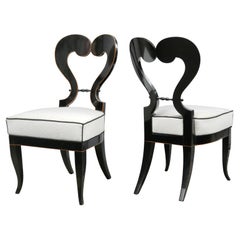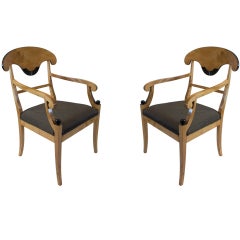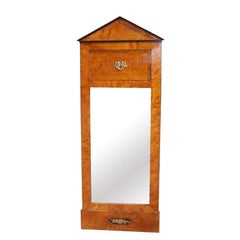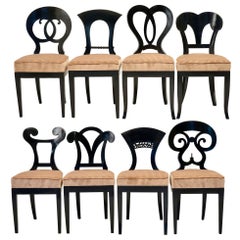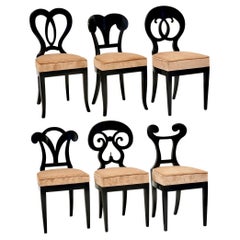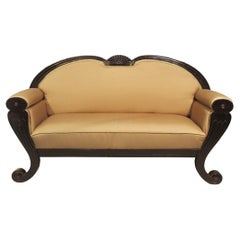Ebonized Biedermeier
Antique Early 19th Century Austrian Biedermeier Dining Room Sets
Upholstery, Pearwood
Antique Early 19th Century Austrian Biedermeier Chairs
Upholstery, Pearwood
Antique Early 19th Century Austrian Biedermeier Chairs
Upholstery, Pearwood
Antique 1820s Austrian Biedermeier Side Chairs
Fruitwood, Pearwood
Antique 19th Century Swedish Biedermeier Dining Room Chairs
Birch
Antique 19th Century Italian Biedermeier Wall Mirrors
21st Century and Contemporary Italian Biedermeier Dining Room Chairs
Velvet, Walnut
21st Century and Contemporary Italian Biedermeier Dining Room Chairs
Velvet, Walnut
Antique Early 19th Century Austrian Biedermeier Sofas
Pearlware, Upholstery
Antique Early 19th Century Austrian Biedermeier Desks and Writing Tables
Pearwood
Antique Early 19th Century Austrian Biedermeier Desks and Writing Tables
Pearwood
Antique Early 19th Century Austrian Biedermeier Commodes and Chests of D...
Brass
Antique Late 19th Century European Biedermeier Drop-leaf and Pembroke Ta...
Ebony, Satinwood
Antique 19th Century German Secretaires
Burl
Vintage 1950s German Biedermeier Cabinets
Maple, Wood
21st Century and Contemporary Italian Biedermeier Dining Room Chairs
Velvet, Walnut
21st Century and Contemporary Italian Biedermeier Dining Room Chairs
Velvet, Walnut
Antique Early 19th Century Austrian Biedermeier Center Tables
Walnut, Wood
Antique 19th Century Austrian Biedermeier Bookcases
Walnut
Antique Mid-17th Century German Biedermeier Vitrines
Walnut
21st Century and Contemporary Italian Biedermeier Dining Room Chairs
Velvet, Walnut
21st Century and Contemporary Italian Biedermeier Dining Room Chairs
Velvet, Walnut
21st Century and Contemporary Italian Biedermeier Dining Room Chairs
Velvet, Walnut
21st Century and Contemporary Italian Biedermeier Dining Room Tables
Velvet, Walnut
21st Century and Contemporary Italian Biedermeier Dining Room Chairs
Velvet, Walnut
20th Century Austrian Biedermeier Center Tables
Wood
21st Century and Contemporary Italian Biedermeier Dining Room Chairs
Velvet, Walnut
Antique Early 19th Century Austrian Biedermeier Center Tables
Walnut
Antique 19th Century Austrian Biedermeier Desks and Writing Tables
Wood, Pearwood, Maple
Antique 1820s German Biedermeier Commodes and Chests of Drawers
Iron
Antique 19th Century German Biedermeier Commodes and Chests of Drawers
Walnut
Antique Early 1900s German Biedermeier Armchairs
Birch
Antique Late 19th Century Austrian Biedermeier Armchairs
Upholstery, Birch
Antique Early 19th Century German Biedermeier Commodes and Chests of Dra...
Walnut
Antique Early 19th Century German Biedermeier Commodes and Chests of Dra...
Mahogany
Antique Early 19th Century German Biedermeier Commodes and Chests of Dra...
Satinwood
Antique 19th Century Austrian Biedermeier Armchairs
Gold Leaf
Antique 19th Century Austrian Biedermeier Commodes and Chests of Drawers
Walnut
Antique 19th Century German Biedermeier Commodes and Chests of Drawers
Walnut
Antique Early 19th Century German Biedermeier Commodes and Chests of Dra...
Walnut
Antique Early 19th Century German Biedermeier Commodes and Chests of Dra...
Cherry
Antique 1820s German Biedermeier Blanket Chests
Iron
Antique Mid-19th Century Austrian Biedermeier Night Stands
Wood, Walnut
Antique Mid-19th Century Austrian Biedermeier Desks and Writing Tables
Walnut
Antique Early 19th Century German Biedermeier Commodes and Chests of Dra...
Walnut
Antique 1820s German Biedermeier Cabinets
Oak, Walnut, Softwood
Antique 1860s Austrian Biedermeier Side Tables
Cherry
Antique 19th Century Austrian Biedermeier Chairs
Upholstery, Wood
Antique Early 19th Century German Biedermeier Secretaires
Iron, Brass
Antique Mid-19th Century Austrian Biedermeier Gueridon
Walnut, Wood
Antique 1830s German Biedermeier Pier Mirrors and Console Mirrors
Other
Antique 1820s German Biedermeier Night Stands
Walnut
Antique 1820s German Biedermeier Gueridon
Iron
Antique Mid-19th Century German Biedermeier Chairs
Upholstery, Wood, Cherry
Antique 19th Century Austrian Biedermeier Dining Room Chairs
Wood
Antique Early 19th Century German Biedermeier Center Tables
Cherry
Antique 19th Century German Biedermeier Cabinets
Fruitwood
- 1
- ...
Ebonized Biedermeier For Sale on 1stDibs
How Much is a Ebonized Biedermeier?
A Close Look at Biedermeier Furniture
The authentic Biedermeier furniture on 1stDibs is representative of the first modern European decorative style not dictated by the tastes of the aristocracy. Following the Napoleonic wars, a growing, wealthy urban middle class in the German-speaking states of Central Europe began to demand rights and privileges once granted only to nobles. To avoid trouble, the upwardly striving confined their political discussions to one another’s homes. And so the salon was born.
Cabinetmakers in cities such as Vienna, Berlin and Mainz began to offer goods that reflected the tastes and needs of the new class. The makers of Biedermeier chairs, tables and other furniture used little or no gilding, silver hardware or other lavish ornament. Ebonized trims are common on Biedermeier cabinetry, and neoclassical elements — lyre-shaped chair splats, carved scrollwork, table supports shaped like Greek columns. But the strongest aesthetic statement came from the wood — richly-grained, honey-colored, often book-matched veneers of walnut and fruitwood.
There are two iconic Biedermeier furniture forms, both made to outfit rooms designed for conversation. One is the sofa, deeply upholstered with a strong, architectural wooden frame. The second is the circular pedestal table, which stood at the center of the room, offering a surface on which to place coffee and cake services; or to roll out a map, or sketch out ideas on paper.
“Biedermeier” was originally a derogatory term — it derives from the pen names of two German magazine writers who mocked bourgeois manners. Looking at the elegant and refined antique, new and vintage Biedermeier furniture offered on 1stDibs, that is now an amusing irony.
